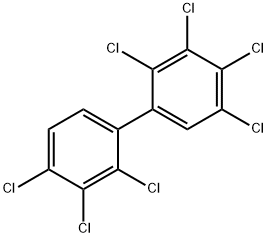35065-30-6

Product Name:
2,2',3,3',4,4',5-HEPTACHLOROBIPHENYL
Formula:
C12H3Cl7
Synonyms:
2,2′,3,3′,4,4′,5-Heptachlorobiphenyl;2,2′,3,3′,4,4′,5-PCB
Inquiry
CHEMICAL AND PHYSICAL PROPERTIES
| Kovats Retention Index | 2491 |
|---|
SAFETY INFORMATION
| Signal word | Warning |
|---|---|
| Pictogram(s) |
 Health Hazard GHS08  Environment GHS09 |
| GHS Hazard Statements |
H373:Specific target organ toxicity, repeated exposure H410:Hazardous to the aquatic environment, long-term hazard |
| Precautionary Statement Codes |
P273:Avoid release to the environment. P391:Collect spillage. Hazardous to the aquatic environment P501:Dispose of contents/container to..… |
COMPUTED DESCRIPTORS
| Molecular Weight | 395.3 g/mol |
|---|---|
| XLogP3 | 7.9 |
| Hydrogen Bond Donor Count | 0 |
| Hydrogen Bond Acceptor Count | 0 |
| Rotatable Bond Count | 1 |
| Exact Mass | 393.802494 g/mol |
| Monoisotopic Mass | 391.805444 g/mol |
| Topological Polar Surface Area | 0 Ų |
| Heavy Atom Count | 19 |
| Formal Charge | 0 |
| Complexity | 313 |
| Isotope Atom Count | 0 |
| Defined Atom Stereocenter Count | 0 |
| Undefined Atom Stereocenter Count | 0 |
| Defined Bond Stereocenter Count | 0 |
| Undefined Bond Stereocenter Count | 0 |
| Covalently-Bonded Unit Count | 1 |
| Compound Is Canonicalized | Yes |
PRODUCT INTRODUCTION
description
2,2',3,3',4,4',5-Heptachlorobiphenyl is one of 209 polychlorinated biphenyls (PCBs). PCBs are a group of synthetic organic compounds with 1-10 chlorine atoms attached to biphenyl. They were manufactured as commercial mixtures but banned in the 1970's because they were found to bioaccumulate and cause harmful health effects. However, PCBs do not break down readily and are still found in the environment. (L4)